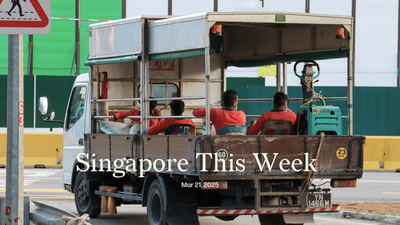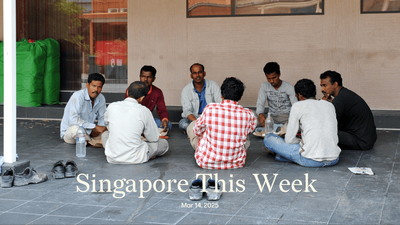Politics: Nobody’s independent
Tomorrow, Singaporeans elect a new president from the three people the government has deemed fit to run: Ng Kok Song, former GIC chief investment officer, Tan Kin Lian, former boss of NTUC Income, and Tharman Shanmugaratnam, former senior minister with the ruling People’s Action Party (PAP). Pre-election discourse suggests that voters are trying to make sense of each candidate’s relative independence. Tharman appears to have no more formal dependency on the establishment, but will always be associated with the PAP. Ng has never been in a political party, but the fund he co-founded is heavily dependent on the state. Tan Kin Lian has been a seemingly independent critic of the PAP for some time, but is now associated with some opposition figures. The candidates’ relative independence is one of the main things discussed in Jom’s pre-election essay, “Nobody’s independent: Singapore’s presidential election”, which was published yesterday.
Politics: The right to vote
In any election, as important as who gets to run is who gets to vote. Every adult citizen, one would think. Yet, even in the world’s most mature democracies, such as the US, there are feverish debates about electoral rolls. Donald Trump’s unbelievable phone call in 2021 to the state secretary of Georgia—key evidence in his latest indictment—shows how far some might go to strike off legitimate votes. Voter suppression is a tactic often used by the powerful against lower-income citizens who may lack proper identification. These are not problems that Singapore generally faces, but there are imperfections in our system. Unlike in the US, voting is mandatory in Singapore. Those who fail to vote risk being barred from voting again. Before every election, those whose names are not on the Registers of Electors can apply to the Election Department (ELD) to be reinstated. Being overseas on polling day is a legitimate excuse. Ahead of tomorrow’s presidential election, ELD restored 32,807 Singaporean voters. But what about those who voted at the general election (GE) in 2020 and yet somehow still got struck off? By last Friday, some 200 Singaporeans had complained to ELD about this. ELD said that electronic registration devices at GE2020 had failed to capture some NRIC details. It’s using more sensitive equipment tomorrow. That’ll be of little comfort to those 200 Singaporeans—and probably more unreported—who won’t get to vote tomorrow. Presumably it’s not ELD’s fault, but theirs: they should have checked the register before the writ of election was issued on August 11th. Separately, amid the enthusiasm about overseas Singaporeans being able to vote by post for the first time, it’s worth remembering that many are off the roster. For those who didn’t travel back during the pandemic for GE2020, they would have had to reinstate themselves, and would have had to have spent at least 30 days in Singapore in the past three years. Only 6,649 of well over 100,000 adult overseas Singaporeans have registered to vote. One last oddity: almost 10,000 voters in Tanjong Pagar were sent an extra polling card, almost all with unique serial numbers. In the seventh month, maybe the ghost of Lee Kuan Yew wanted his former constituents to have a bigger say tomorrow. (ELD says they won’t.)
Society: Spare the rod
A former preschool teacher was charged yesterday with the offence of ill-treatment of a child or young person. If convicted, she could be jailed for up to eight years or fined up to S$8,000, or both. Police had arrested the woman on Tuesday after video clips of her allegedly mistreating children under her care at Kinderland @ Woodlands Mart went viral. In the clips, the 33-year-old, who’s since been dismissed, hit and rough-handled several children. When some refused to drink water, she pried their mouths open, as they cried and struggled to escape her grip. What made it more troubling was that there were other staff in the classroom, pointing perhaps to an accepted work culture? “Such unprofessional acts…cannot be condoned and the staff must be brought to task,” said Poh Li San, a PAP member of Parliament, who’s assisting the parents of the affected children. A day later, a video of another teacher hitting a child surfaced online. Both cases are being investigated by the police and Early Childhood Development Agency (ECDA), which is also looking into the roles played by the centre leader and operator of a Kinderland preschool branch. The leaked videos have roused the public; incensed that an adult placed in charge of the care and safety of kids had instead subjected them to apparent violence. Some 80-90 percent of children in Singapore typically attend preschool (infant/childcare and kindergarten). Full-day fees cost hundreds to more than a thousand dollars a month. It’s a booming industry that clearly needs stricter regulation. This could mean more stringent hiring policies, installing cameras in every classroom, more frequent checks by the ECDA and harsher penalties for recalcitrant employers. It’s incumbent on schools to also investigate why some teachers resort to inappropriate behaviour and how to prevent it, like providing better wages, welfare and working conditions. One of Kinderland Singapore’s responses so far is to ban its staff from using personal devices during teaching hours: “We hope that these measures will better protect all.” This move will certainly protect Kinderland. If not for the videos, its staff wouldn’t be in the situation that they’re in now.
Earth: Reduce, reuse, karung guni
Singapore recycles too little plastic: only six percent of the 1.76bn plastic items used each year, CNA reported last week. There are many reasons for this—a lack of designated recycling facilities and other infrastructure, the average consumer’s lack of knowledge about what plastics can be recycled or how to recycle them, and growing import restrictions overseas that have made it harder for Singapore to export recycled plastics. But one of the biggest challenges to recycling plastic is contamination. Because Singapore adopts a commingled collection system, all types of recyclable waste, including paper, metal and glass, are dumped into those same familiar blue recycling bins. The whole bin is then emptied into one recycling truck, which means that a rogue packet of leftover cai fan can contaminate the entire truck’s worth of recyclables. As a result, 60 to 70 percent of all recyclable waste received is incinerated. A commingled system, said Pamela Low of Stridy, a clean-up community, often results in “wish-cycling”: dumping what one wishes could be recycled, not just what can be. However, the National Environment Agency (NEA) has no plans to implement a stricter recycling system like the ones found in countries such as Germany, Japan and South Korea, where residents are required to sort their waste into specific designated bins. Citing the increase in cost and carbon emissions from more truck trips in the collection process, the agency is instead focusing on “encourag[ing] everyone to recycle right”. Its four-year-old Recycle Right campaign aims to raise the domestic recycling rate to 30 percent by 2030 (it was 12 percent last year). Some environmentalists are encouraging more Singaporeans to sell second-hand items to karung guni men, scrap dealers who typically go door-to-door collecting old newspapers and other unwanted items. It’s estimated that karung guni men collect close to nine times more than the national recycling effort, and are good at bundling recyclables without contamination. But after exports were stalled during the pandemic, the karung guni trade has never fully recovered. Many of these elderly scrap dealers have retired. Perhaps NEA should consider incorporating them into “formal roles in waste management firms and recycling companies,” suggested Kavickumar Muruganathan, a sustainability professional. In the meantime, load up your tote bag with a reusable bottle, metal straw and lunch box.
History weekly by Faris Joraimi
Two weeks ago, I mentioned historical Bugis relations with Aboriginal Australians. It seems that ties between Australia and the Malay-Indonesian world lasted much longer than I thought. The coastal town of Broome in north-western Australia hosts a cosmopolitan past centred on its lucrative pearling industry. Known as Rubibi to the Yawuru people who are indigenous to its surrounding land and sea, Broome was exempt from the racist 1901 “White Australia” policy that kept out migrants of colour (and reinforced existing oppression of First Nations peoples). So in the 20th century, Broome became a destination for Asian male labour, including Chinese, Filipinos, and Timorese, but mostly Japanese and Malays. They went to do the arduous and dangerous work of pearl-diving that white settlers avoided. Singaporean choreographers Soultari Amin Farid and Zee Zunnur have paired with Australian dance company Marrugeku, to tell this little-known story of international encounters on a remote edge of the Indian Ocean. Called “Mutiara” (Malay for pearl), their performance work premieres tomorrow, September 1st, at the Broome Civic Centre. Among their local collaborators is Dalisa Pigram, Marrugeku’s artistic co-director of mixed Yawuru-Malay ancestry, and Ahmat Bin Fadal, a Singapore-born Malay pearl-diver who went to Broome in 1962 and serves as the project’s main history advisor. Ahmat is part of the large post-world war two influx of Malays to Broome who stayed, marrying local Yawuru women. According to Soultari and Zee’s conversations with local elders, including Ahmat’s wife “Nana” Sally, the “Malay boys” played prominent roles in community-building and contributing to Broome’s culture. At 83, Ahmat Bin Fadal is among the last surviving Malay pearl-divers still residing there. Two from Negeri Sembilan passed away this year, both in their 90s. This history also contains a cruel legacy of labour exploitation, as pearl-diving in Broome was first performed by Aboriginal girls kidnapped and forced to work by white settlers (a practice called “blackbirding”). The later pearl-divers were indentured and paid little. In the pre-SCUBA era, they wore heavy copper suits and relied on piped air, communicating with those on board through a system of rope-tugging. The job’s difficulties prompted one Sumatra-born diver, Samsudin Bin Katib to organise his fellow Malay workers and lead a general strike in 1948. Singapore’s own history mirrors this twin condition, of great inequity accompanying cultural diversity.
Arts: Revamping Orchard Road at the cost of losing art heritage?
The iconic sculptural reliefs that make up the façade of the former Hilton Hotel may soon be no more, said Darren Soh, an architectural photographer and chronicler of Singapore’s urban history, on Facebook. Building owner Hotel Properties Limited (HPL) group announced on Monday that the Urban Redevelopment Authority (URA) has approved a major redevelopment proposal: to convert the former Hilton (rebranded as voco Orchard), Forum the Shopping Mall, and HPL House into a mixed-use development with hotel, retail, office and residential spaces. Soh said that it’s unclear whether HPL will save the reliefs, made for the Hilton by Malaya-born muralist Gerard d’Alton Henderson. Covering an area of over 5,000 sq ft, they feature motifs found in South-east Asian art like triangular tumpal and wayang topeng masks. They were installed in 1971 and are a relic from an earlier iteration of Orchard Road: before the first annual Christmas light-up in 1984, and multi-storey mall (Plaza Singapura in 1974). The artwork’s story is inextricably tied up with that of Singapore’s main shopping district. Three of its panels were removed several years ago to make space for Giorgio Armani’s storefront, just one of the many luxury brands that Club 21 introduced to Singapore. The retail group is owned by Christina Ong, wife of Ong Beng Seng, HPL managing director (who’s now under investigation for possible F1-related improprieties). The couple has stakes in numerous hotels, residential buildings, and malls in an area that has become increasingly dominated by a handful of large corporations and REITs. Now, the precinct is plagued by low footfall and high vacancy rates. The HPL redevelopment is only one part of a URA-led era of rejuvenation. We’ll have to wait to see if the new Orchard Road makes space for Henderson’s reliefs, and other pieces of Singapore’s public art heritage.
Arts: New music at Mosaic Music Series
Three Singaporean acts will headline shows at The Esplanade in the coming months. Subsonic Eye, shazza and Blush will perform new music as part of the arts centre’s long-running Mosaic Music Series. 22-year-old singer-songwriter shazza is the newest on the block but has already made a name for herself. Following the release of her debut album “Chapter One” in July, Spotify featured her on a billboard in Times Square as part of its programme to promote gender equity in music, EQUAL. The upcoming show will be her largest yet—90 minutes long and accompanied by an 11-member band. Indie rock band Subsonic Eye is also celebrating its fourth album. “All Around You” is set for a September 13th release on American independent record label Topshelf Records. The band’s Singapore show will be the first in this album cycle before it embarks on a month-long US tour. Finally, alt-rock band Blush will launch its debut album “Supercrush” in November, having signed with American independent record label No Sleep Records in June. Blush made its live debut at The Esplanade’s flagship music festival Baybeats in 2021. Its members play in bands like Sobs, Forests, Marijannah and Cosmic Child. shazza performs on September 2nd at the Esplanade Recital Studio. Subsonic Eye and Blush will perform at the Esplanade Annexe Studio on September 30th and November 11th respectively. More information can be found on Mosaic’s website.
Business: Grabbing better margins and better days
Grab’s Q2 2023 performance, with revenues surging 77 percent year-on-year (YoY) to US$567m (S$769m), presents a robust growth story. Losses narrowed by 74 percent to US$148m (S$200m). The adjusted EBITDA (earnings before interest, taxes, depreciation and amortization)—a critical measure of operational profitability—improved by 92 percent YoY, positioning the firm to break even in Q3 2023, a quarter earlier than projected. How was Grab able to achieve both top-line growth and bottom-line improvement in the last quarter? One reason would be the impressive performance from the deliveries segment, recording an all-time high owing to affordability initiatives and an expanding GrabUnlimited subscriber base. The mobility segment also reported substantial growth, with a 28 percent rise in Gross Merchandise Value (GMV) to US$1.3bn (S$1.76bn), primarily attributable to growing domestic demand and tourist ride-hailing. While the financial services segment saw only a 1 percent YoY increase in total payment volume and a 13 percent decline in GMV, segment revenues soared by 223 percent to US$40m (S$54.25m). Interestingly, amidst these growth metrics, Grab’s strategy appears to deviate from its competitors, such as Sea Group, of pursuing market share through incentives. The GrabUnlimited subscription service has played a crucial role in downscaling promotional expenses, contributing to margin improvements. Specifically, it provides everyday low pricing that helps the company retain customers. After the earnings release, Grab’s share prices surged 4.8 percent in pre-market trading. This trend, if sustained, may have lasting implications for Grab’s survival on the NASDAQ.
Business: Caffeinated competition
Indonesian coffee chain Fore Coffee plans to open a branch in Singapore by Q4 2023, its maiden expansion into the international market. Matthew Ardian, chief marketing officer, attributed high per capita coffee consumption among Singaporeans, surpassing even Indonesians, as the reason for choosing the city-state. Fore Coffee’s growth follows similar moves by other VC-backed Indonesian coffee brands, such as Kopi Kenangan and Tanamera Coffee, indicating a trend of regional coffee chain expansion. However, Fore Coffee isn’t limiting its growth to Singapore; the brand is also planning to increase its presence in Indonesia, especially into its eastern regions, by collaborating with local real estate properties. Despite facing challenges during the pandemic, leading to store closures and a pause in its expansion, Fore Coffee has been profitable since Q3 2021. Significantly, in January 2022, the firm hired a new CEO, Vico Lomar, a seasoned executive who’s worked with Dunkin’ Donuts and Krispy Kreme. While Fore Coffee last raised US$9.5m (S$12.88m) in a series A round, which featured investors like East Ventures, Pavilion Capital and Insignia Ventures Partners, competition in Singapore’s coffee chain segment is stiff. For one, Fore Coffee will go up against the US$50m (S$67.82m) war chest that Singapore-based Flash Coffee announced recently, as well as Chinese coffee chain Luckin Coffee, which has 8,200 stores in China and recently launched in Singapore.
If you enjoy Jom’s work, do get a paid subscription today to support independent journalism in Singapore.








